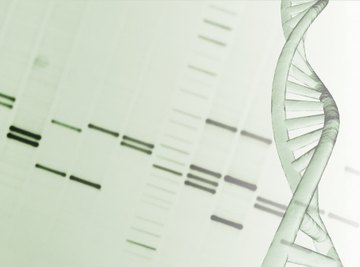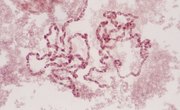
Medical advances have taken science to new heights with the ability to improve the quality of life for many human beings. Scientists and researchers can test, diagnose and predict genetic disorders by the use of karyotypes. Karyotypes are arrangements of a person's chromosomes into an organized profile allowing scientists to identify specific genetic disorders. By writing karyotypes you can unlock medical mysteries in your work.
- Picture of chromosomes from a test subject
- Pen or pencil
Other abnormal karyotypes will be written differently.
Match the homologous chromosomes according to their size (descending order), centromere position and banding pattern. These three indicators will serve as a guide for properly matching the chromosomes creating your karyotype.
Write the total number of chromosomes for the test subject used (humans, dogs, pigs. etc. have different numbers of chromosomes). For people the number is 46, unless there are defective or additional chromosomes.
Place a comma behind the first number. This is followed by identifying the sex chromosomes XX (female) or XY (male), write the appropriate sex. (eg. 46,XX is female; 46, XY is male)
Add a plus or minus sign to the affected chromosome number for an abnormal karyotype, placing it behind a comma after the sex chromosome. The plus or minus sign signifies there is an added chromosome or missing chromosome (or a chromosome can be missing parts). For a male with an extra number 19 chromosome, the karyotype would be displayed as 47,XY,+19 as one chromosome was added to the total of 46; +19 is displayed at the end, identifying the additional chromosome.
Add (or subtract) one to or from your total number in the first set of numbers for the abnormal karyotype. If there is only a part of the chromosome missing or added, the first set of total numbers will not be affected.
Write 'del' when a chromosome is missing only parts. Del is written in a third set of numbers (replacing the plus and minus sign and affected chromosome) before a set of parenthesis. Within the parenthesis write the number of the affected chromosome incurring change.
Make another set of parenthesis directly after the first set of parenthesis. Within the parenthesis write a 'p' for the short arm of the chromosome or a 'q' for the long arm. This establishes which part (or arm) of the chromosome is missing.
Find the 'break point' of the change indicating the chromosome in the second set of parenthesis. Put the p or q before the break point chromosome. Example, a female missing the bottom arm of a chromosome 5 would be expressed as 46,XX, del(5)(q16). 'Del' says the chromosome is missing something. (5) delineates the origin of the problem. 'Q' indicates the missing part of the chromosome is the long arm. '16' identifies the break point chromosome.
Things You'll Need
Warnings
References
Warnings
- Other abnormal karyotypes will be written differently.
About the Author
Deronte' Smith began his professional writing career in 1996 with Trader Publications, writing listings for "Auto Trader Magazine." He has also worked for the "Central Kentucky News Journal" and the "Kentucky Kernel." Smith holds a Bachelor of Arts in English from the University of Kentucky.
Photo Credits
Comstock/Comstock/Getty Images
